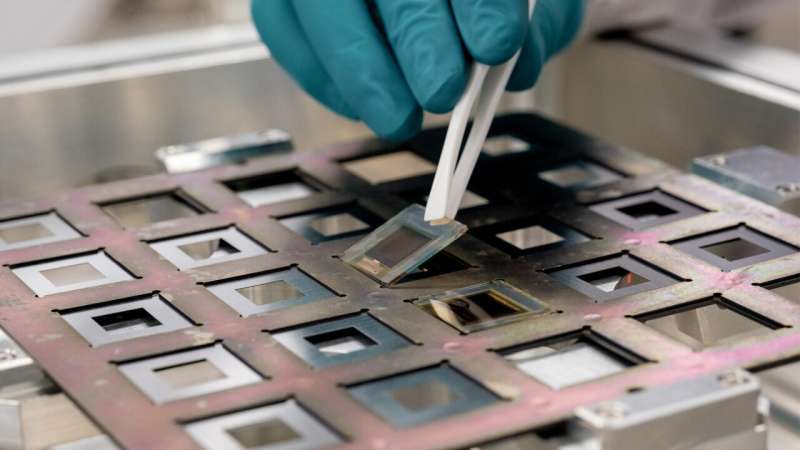Perovskite solar cells set new world record for power conversion efficiency

Perovskite solar cells designed by a team of scientists from the National University of Singapore (NUS) have attained a world record efficiency of 24.35% with an active area of 1 cm2. This achievement paves the way for cheaper, more efficient and durable solar cells.
To facilitate consistent comparisons and benchmarking of different solar cell technologies, the photovoltaic (PV) community uses a standard size of at least 1 cm2 to report the efficiency of one-sun solar cells in the “Solar cell efficiency tables.” Prior to the record-breaking feat by the NUS team, the best 1 cm2 perovskite solar cell recorded a power conversion efficiency of 23.7%. This ground-breaking achievement in maximizing power generation from next-generation renewable energy sources will be crucial to securing the world’s energy future.
Perovskites are a class of materials that exhibit high light absorption efficiency and ease of fabrication, making them promising for solar cell applications. In the past decade, perovskite solar cell technology has achieved several breakthroughs, and the technology continues to evolve.
“To address this challenge, we undertook a dedicated effort to develop innovative and scalable technologies aimed at improving the efficiency of 1 cm2 perovskite solar cells. Our objective was to bridge the efficiency gap and unlock the full potential of larger-sized devices,” said Assistant Professor Hou Yi, leader of the NUS research team comprising scientists from the Department of Chemical and Biomolecular Engineering under the NUS College of Design and Engineering as well as the Solar Energy Research Institute of Singapore (SERIS), a university-level research institute in NUS.
He added, “Building on more than 14 years of perovskite solar cell development, this work represents the first instance of an inverted-structure perovskite solar cell exceeding the normal structured perovskite solar cells with an active area of 1 cm2, and this is mainly attributed to the innovative charge transporting material incorporated in our perovskite solar cells. Since inverted-structure perovskite solar cells always offer excellent stability and scalability, achieving a higher efficiency than for normal-structured perovskite cells represents a significant milestone in commercializing this cutting-edge technology.”
This milestone achievement by Asst Prof Hou Yi and his team has been included in the “Solar cell efficiency tables (Version 62)” published in the journal Progress in Photovoltaics on 21 June 2023. These consolidated tables show an extensive listing of the highest independently confirmed efficiencies for solar cells and modules.
Low-cost, efficient and stable solar cell technology
The record-breaking accomplishment was made by successfully incorporating a new interface material into perovskite solar cells.
“The introduction of this novel interface material brings forth a range of advantageous attributes, including excellent optical, electrical, and chemical properties. These properties work synergistically to enhance both the efficiency and longevity of perovskite solar cells, paving the way for significant improvements in their performance and durability,” explained team member Dr. Li Jia, postdoctoral researcher at SERIS.
The promising results reported by the NUS team mark a pivotal milestone in advancing the commercialization of a low-cost, efficient, stable perovskite solar cell technology. “Our findings set the stage for the accelerated commercialization and integration of solar cells into various energy systems. We are excited by the prospects of our invention that represents a major contribution to a sustainable and renewable energy future,” said team member Mr. Wang Xi, an NUS doctoral student.
Toward a greener future
Building upon this exciting development, Hou and his team aim to push the boundaries of perovskite solar cell technology even further.
Another key area of focus is to improve the stability of perovskite solar cells, as perovskite materials are sensitive to moisture and can degrade over time. Hou commented, “We are developing a customized accelerating aging methodology to bring this technology from the lab to the fab. One of our next goals is to deliver perovskite solar cells with 25 years of operational stability.”
The team is also working to scale up the solar cells to modules by expanding the dimensions of the perovskite solar cells and demonstrating their viability and effectiveness on a larger scale.
“The insights gained from our current study will serve as a roadmap for developing stable, and eventually, commercially viable perovskite solar cell products that can serve as sustainable energy solutions to help reduce our reliance on fossil fuels,” Hou added.
More information:
Martin A. Green et al, Solar cell efficiency tables (version 62), Progress in Photovoltaics: Research and Applications (2023). DOI: 10.1002/pip.3726. onlinelibrary.wiley.com/doi/full/10.1002/pip.3726
Citation:
Perovskite solar cells set new world record for power conversion efficiency (2023, June 22)
retrieved 22 June 2023
from https://techxplore.com/news/2023-06-perovskite-solar-cells-world-power.html
This document is subject to copyright. Apart from any fair dealing for the purpose of private study or research, no
part may be reproduced without the written permission. The content is provided for information purposes only.
For all the latest Technology News Click Here
For the latest news and updates, follow us on Google News.

